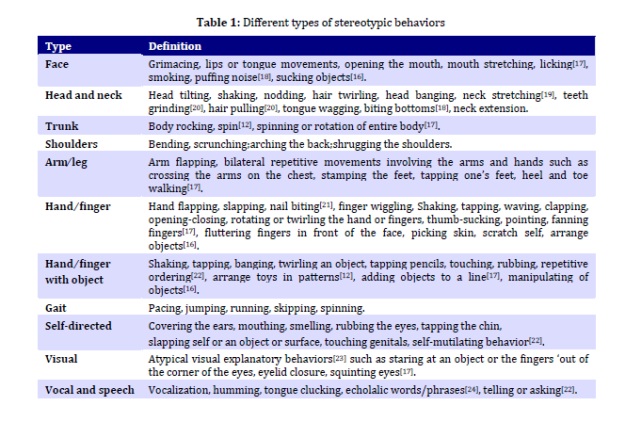How Do Autistic Brains Differ in Repetitive Behavior?
Over forty percent of children with ASD engage in some type of repetitive behavior, with more boys than girls afflicted[1]. It is the extended frequency and duration of such behavior that can impair daily functioning. The stereotypical movements can also stigmatize the child, hindering opportunities for socialization with other children.
Repetitive behavior is not unique to autism: it occurs in other neurodevelopmental disorders such as, but not limited to, Tourette’s syndrome and Obsessive Compulsive disorder.
 Repetitive behaviors are divided into four subtypes: 1) repetitive motor mannerisms or stereotypies; 2) nonfunctional routines or rituals; 3) preoccupation with restricted interests; and 4) preoccupation with parts of objects. Examples are shown in the following Table.
Repetitive behaviors are divided into four subtypes: 1) repetitive motor mannerisms or stereotypies; 2) nonfunctional routines or rituals; 3) preoccupation with restricted interests; and 4) preoccupation with parts of objects. Examples are shown in the following Table.
Children with ASD show more varied types of repetitive behavior than those with other neurodevelopmental disorders[2]. Children with ASD also perform arm and finger movements and experience coordination difficulties more often than those with other disorders[3].
Repetitive behaviors can increase in frequency due to internal behavioral states such as anxiety, stress, boredom, or excitement[4]. Repetitive behavior occurs more often in intellectually disabled children who have ASD than in high functioning children with ASD. For intellectually disabled autistic children, anxiety appears to be a stronger motivator than sensory stimulation. However, hypersensitivity to various sensory stimuli, particularly touch, smell, taste, and light may lead to anxiety in children with ASD that is quelled to some extent by performing the repetitive action[5].
Treatments for repetitive behavior includes either medicinal treatment or behavioral intervention.
Medicinal treatment, however, appears to affect general behavioral states such as irritability and aggression that only secondarily reduce the symptoms.
References
[1] Ghanizadeh A (2010) “Climical approaches to motor stereotypiues in autistic children.” Iran J Pediatr 20(2): 149-159.
[2] Leekam SR, Prior MR, Uljarevic M (2011) “Restricted and repetitive behaviors in autism spectrum disorders: A review of research in the last decade.” Psych Bull 137(4): 562-593.
[3] Goldman et al.
[4] Goldman, S, Wang C, Salgado MW, Greene PE, Kim M, Rapin I (2008). “Motor stereotypies in children with autism and other developmental disorders.” Dev Med Child Neurol 51:30-38.
[5] Boyd BA , Baranek GT, Sideris J, Poe MD, Watson LR, Patten E, Miller H (2010). “Sensory features and repetitive behaviors in children with autism and developmental delays. Autism Res 3(2): 78-87.

